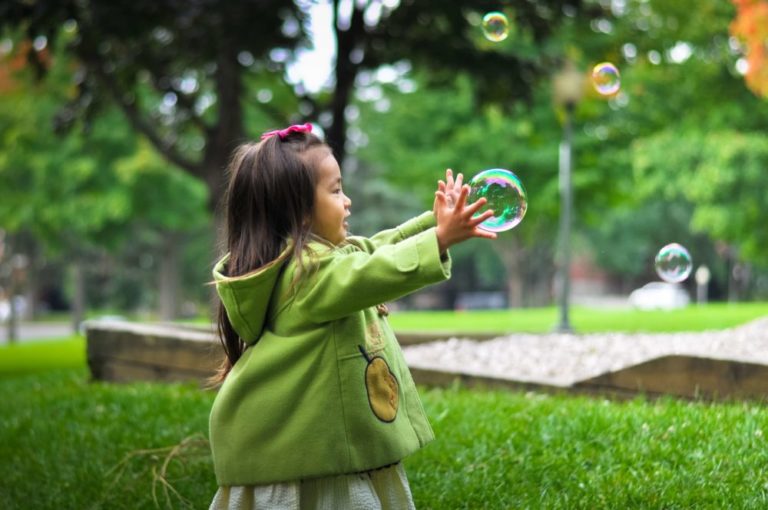An Overview of Early Childhood Development
Early childhood development focuses on a persiod of remarkable physical, cognitive, social, and emotional change. Infants enter the world with a limited range of skills and abilities. Watching a child develop new motor, cognitive, language, and social skills is a source of wonder for parents and caregivers. During the early childhood years, such growth and…

Early childhood development focuses on a persiod of remarkable physical, cognitive, social, and emotional change. Infants enter the world with a limited range of skills and abilities.
Watching a child develop new motor, cognitive, language, and social skills is a source of wonder for parents and caregivers. During the early childhood years, such growth and change happen rapidly, so fast that adults often marvel at how quickly certain skills emerge.
The study of human development is a rich and varied subject. We all have personal experience with development, but it is sometimes difficult to understand exactly how and why people grow, learn, and change.
Developmental psychology seeks to understand and explain how people grow and change through the entire lifespan. Researchers study the enormous range of influences, including how genetics shape a child’s development as well as how experiences play a role.
Let’s take a closer look at early childhood development, including the basics of physical development and psychological growth.
Physical Early Childhood Development
Physical changes are an important component of early childhood development. As a child matures, parents eagerly await important milestones, such as learning how to roll over and crawl. Each of these represents a part of physical development.
The maturation process happens in an orderly manner; certain skills and abilities generally occur before other milestones are reached. For example, most infants learn to crawl before they learn to walk.
However, it is also important to realize that the rate at which these developmental milestones are reached can vary. Some children learn to walk earlier than their same-age peers, while others may take a bit longer.
Motor Skill Development
As a child grows, his or her nervous system becomes more mature. As this happens, the child becomes more and more capable of performing increasingly complex actions.
The rate at which these motor skills emerge is sometimes a worry for parents. Caregivers frequently fret about whether or not their children are developing these skills on a normal timeline.
As mentioned above, rates may vary somewhat. However, nearly all children begin to exhibit these motor skills at a fairly consistent rate unless some type of disability is present.
There are two types of motor skills:
Gross Motor Skills
Gross (or large) motor skills involve the larger muscles including the arms and legs. Actions requiring gross motor skills include walking, running, balance, and coordination. When evaluating gross motor skills, the factors that experts look at include strength, muscle tone, movement quality, and the range of movement.
Fine Motor Skills
Fine (or small) motor skills involve the smaller muscles in the fingers, toes, eyes, and other areas. The actions that require fine motor skills tend to be more intricate, such as drawing, writing, grasping objects, throwing, waving, and catching.
Physical Growth
Physical development in children follows a directional pattern:
Large to Small
Large muscles develop before small muscles. Muscles in the body’s core, legs and arms develop before those in the fingers and hands. Children learn how to perform gross (or large) motor skills, such as walking before they learn to perform fine (or small) motor skills such as drawing.
Central to Distal
The center of the body develops before the outer regions. Muscles located at the core of the body become stronger and develop sooner than those in the feet and hands.
Top to Bottom
Development goes from the top down, from the head to the toes. This is why babies learn to hold their heads up before they learn how to crawl.
Cognitive Early Childhood Development
Early childhood development not only focuses on the amazing physical growth that kids experience; it also encompasses remarkable mental development. Cognitive abilities associated with memory, reasoning, problem-solving, and thinking continue to emerge throughout childhood.
Piaget’s Theory
When it comes to childhood cognitive development, it would be impossible to avoid mentioning the work of psychologist Jean Piaget.
After receiving his doctoral degree at age 22, Jean Piaget began a career that would have a profound impact on both psychology and education. Through his work with Alfred Binet, Piaget developed an interest in the intellectual development of children.
Based on his observations, he concluded that children are not less intelligent than adults, they simply think differently.
Albert Einstein called Piaget’s discovery “so simple only a genius could have thought of it.”
Piaget created a theory of cognitive development that described the basic stages that children go through as they mentally mature. He believed that children are like “little scientists,” actively trying to make sense of the world rather than simply soaking up information passively.
Schemas
One of the key concepts in Piaget’s theory is the use of schemas. According to Piaget, schemas are cognitive frameworks or concepts that help people organize and interpret information.
As experiences happen, this new information is used to modify, add to, or completely change previously existing schemas. For example, a young girl may have a schema about a type of animal, such as a cat. According to her schema, cats are furry and have four legs.
When she first encounters a dog, she might initially believe that the animal is a cat. Once she learns that this is actually a dog, she will revise her schema for cats and create a new category of knowledge for dogs.
Language Early Childhood Development
There is perhaps nothing more amazing than the emergence of language in children. Have you ever marveled at how a child can go from saying just a few words to suddenly producing full sentences in just a short matter of time?
Researchers have found that language development begins before a child is even born, as a fetus is able to identify the speech and sound patterns of the mother’s voice. By the age of four months, infants are able to discriminate sounds and even read lips.
Researchers have actually found that infants are able to distinguish between speech sounds from all languages, not just the native language spoken in their homes.
However, this ability disappears around the age of 10 months, and children begin to only recognize the speech sounds of their native language.
By the time a child reaches age three, he or she will have a vocabulary of approximately 3,000 words.
Theories of Language Development
So how exactly does language emerge during early childhood development? Researchers have proposed several different theories to explain how and why language development occurs.
Behavioral Theories
For example, the behaviorist theory of B.F. Skinner suggested that the emergence of language is the result of imitation and reinforcement.
Nativist Theory
The nativist theory of Noam Chomsky suggested that language has an inherent human quality and that children are born with a language acquisition device that allows them to produce language once they have learned the necessary vocabulary.
Critical Period Theory
Critical period theories suggested that children are most sensitive to language acquisition at certain points in development. If language is not learned during these critical points, this theory suggests that language acquisition will never occur.
The famous case of Genie illustrated how critical periods work. Genie was a young girl who was horrifically abused and deprived of early language experiences.
As a result, she never learned language during early childhood. Despite efforts to help her acquire language, it appeared that her early deprivation interfered with her ability to learn language.
How Parents Facilitate Language Development
Researchers have found that in all languages, parents utilize a style of speech with infants known as infant-directed speech, or motherese (aka “baby talk”). If you’ve ever heard someone speak to a baby, you’ll probably immediately recognize this style of speech.
It is characterized by a higher-pitched intonation, shortened or simplified vocabulary, shortened sentences, and exaggerated vocalizations or expressions. Instead of saying “Let’s go home,” a parent might instead say “Go bye-bye.”
Infant-directed speech has been shown to be more effective in getting an infant’s attention as well as aiding in language development. Researchers believe that the use of motherese helps babies learn words faster and easier. As children continue to grow, parents naturally adapt their speaking patterns to suit a child’s growing linguistic skills.
Underextension
Another common occurrence that parents may observe is known as underextension.
Underextension is a phenomenon that occurs during the early phases of language development. Around the age of 18 months, a child’s vocabulary begins to grow considerably, adding an average of 100 words each month. However, sometimes these words can be applied incorrectly.
Underextension involves not applying a new word to objects that are included in the meaning of that word.
Kids apply the word too narrowly. For example, a child might learn the word dog but might only use it to refer to his own dog rather than all of the other dogs that he encounters.
As children grow older and gain an even broader vocabulary, instances of underextension begin to decline.
Stages of Language Development
Language acquisition occurs through a number of stages:
Babbling
The first stage of language development is known as the prelinguistic, babbling or cooing stage. During this period, which typically lasts from the age of three to nine months, babies begin to make vowel sounds such as oooooo and aaaaaaa.
By five months, infants typically begin to babble and add consonant sounds such as ba-ba-ba, ma-ma-ma or da-da-da.
Single Words
The second stage is known as the one-word or holophase stage of language development. Around the age of 10 to 13 months, children will begin to produce their first real words.
While children are only capable of producing a few, single words at this point, it is important to realize that they are able to understand considerably more. Infants begin to comprehend language about twice as fast as they are able to produce it.
Two Words
The third stage begins around the age of 18 months, when children begin to use two word sentences. These sentences usually consist of just nouns and verbs, such as “Where daddy?” and “Puppy big!”
Multi-Word Sentences
Around the age of two, children begin to produce short, multi-word sentences that have a subject and predicate. For example, a child might say “Mommy is nice” or “Want more candy.”
As children age, they continue to learn more new words every day. By the time they enter school around the age of five, children typically have a vocabulary of 10,000 words or more.
Final Thoughts
Early childhood development is a period of rapid growth and change. In addition to the obvious physical signs of growth, children are also gaining a greater understanding of language, the world, themselves, and those around them.
Sources:
Berk, L. E. (2006). Chapter 9 – Child Development (8th ed). Pearson.
Bjorkland, B. R. (1995). Language development and cognition. In David F. Bjorkland (Ed.), Children’s thinking: Developmental function and individual differences. Pacific Grove, CA: Brooks/Cole.
Deckner, D. F., Adamson, L. B., & Bakeman, R. (2003). Rhythm in mother-infant interactions. Infancy, 4, 201-217.
Fernald, A. (1985). Four-month old infants prefer to listen to motherese. Infant Behavior and Development, 8, 181-182.
Bayley, N. (1993). Bayley Scales of Infant Development (2nd ed.). New York: Psychological Corp.





